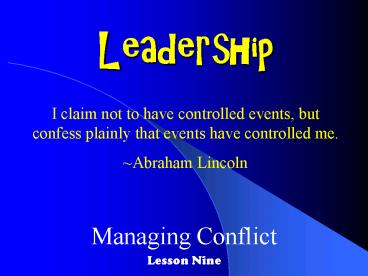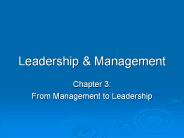Leadership - PowerPoint PPT Presentation
1 / 13
Title:
Leadership
Description:
Leadership I claim not to have ... The Two Types of Conflict A. Positive influence and serves the interests of the organization B. Focuses on personalities instead of ... – PowerPoint PPT presentation
Number of Views:329
Avg rating:3.0/5.0
Title: Leadership
1
Leadership
I claim not to have controlled events, but
confess plainly that events have controlled
me. Abraham Lincoln
- Managing Conflict
- Lesson Nine
2
1. What is conflict?
- A. Conflict is inevitable and will occur often
- B-1. One person perceives his or her interests
are being opposed - B-2. Sufficient breakdown in the normal
activities between people that creates difficulty
in working together
3
2. The Two Types of Conflict
- A. Positive influence and serves the interests of
the organization - B. Focuses on personalities instead of issues and
hinders the achievement of organization goals - C. Asset or a liability
4
3. The Common Causes of Conflict
- A. Produce more conflict
- B. As the result of personality differences or
value systems - C. Proactive, and carefully read early warning
signs
5
4. The Five Conflict Strategies
- A. Pattern becomes a behavioral style
The following are the five conflict strategies
B. Mopicteng C. Domtomiccnaga D. Divingoa E.
Batcoralilong F. Songrimpomic
6
4. The Five Conflict Strategies
A. Pattern becomes a behavioral style
The following are the five conflict strategies
B. Competing C. Domtomiccnaga D. Divingoa E.
Batcoralilong F. Songrimpomic
7
4. The Five Conflict Strategies
A. Pattern becomes a behavioral style
The following are the five conflict strategies
B. Competing C. Accommodating D. Divingoa E.
Batcoralilong F. Songrimpomic
8
4. The Five Conflict Strategies
A. Pattern becomes a behavioral style
The following are the five conflict strategies
B. Competing C. Accommodating D. Avoiding E.
Batcoralilong F. Songrimpomic
9
4. The Five Conflict Strategies
A. Pattern becomes a behavioral style
The following are the five conflict strategies
B. Competing C. Accommodating D. Avoiding E.
Collaborating F. Songrimpomic
10
4. The Five Conflict Strategies
A. Pattern becomes a behavioral style
The following are the five conflict strategies
B. Competing C. Accommodating D. Avoiding E.
Collaborating F. Compromising
11
5. How Can Leaders Manage Conflict?
A. Manage it productively to obtain positive
change and avoid negative consequences
Six ways to manage conflict
12
B. Establish rules and procedures C. Referred to
a common superior D. Liaison is appointed E. Task
forces F. Arbitrators, consultants, and
mediators G. Company training in conflict
management
13
(No Transcript)































